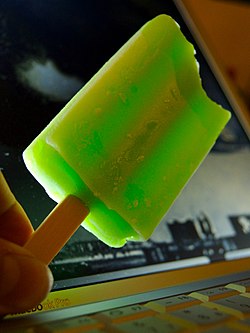 |
| A green popsicle |
Ice pop
From Wikipedia, the free encyclopedia
|
|---|
|
|
Alternative names
|
Freezer pop, ice pop, ice lolly, lolly ice, ice lollipop, ice block, icy pole |
|
Place of origin
|
United States |
| Creators |
Frank Epperson |
|
Main ingredients
|
Water, flavouring (such as fruit juices) |
|
|
200 kcal (837 kJ) |
|
A
popsicle (
Canada and the
United States),
freeze pop (
Ireland),
ice lolly (
United Kingdom and
Ireland),
ice block,
icy pole (parts of
Australia and
New Zealand),
ice pop, or
freezer pop (
U.S. and
Republic of Ireland) is a water-based frozen snack. It is made by freezing flavored liquid (such as
fruit juice) around a stick. Often, the juice is
colored artificially.
Once the liquid freezes solid, the stick can be used as a handle to
hold the ice pop. When a popsicle does not have a stick, it is called,
among other names, a
freezie.
History
Frank Epperson of
Oakland,
California, popularized popsicles after patenting the concept of "frozen ice on a stick" in 1923. He initially called it the Epsicle. A couple of years later, Epperson sold the rights to the invention and the
Popsicle brand to the Joe Lowe Company in New York City.
Epperson claimed to have first created an ice pop in 1905 at the age
of 11 when he accidentally left a glass of powdered soda and water with a
mixing stick in it on his porch during a cold night. However, the
evidence for this is scant.
Terminology
In the United States and Canada frozen ice on a stick is generically referred to as a
popsicle due to the early popularity of the
Popsicle brand, and the word has become a
genericized trademark to mean any ice pop or freezer pop, regardless of brand or format. (The word is a
portmanteau of
pop and
icicle.) They are also called an
ice pop or
freezer pop in the United States. In Ireland the product is also referred to as a
freeze pop. In the Caicos Islands it is referred to as an ice saver. In the United Kingdom the term
ice lolly is used.
Ice block is used in parts of Australia and New Zealand.
Homemade ice pops
An alternative to the store-bought ice pops is making them at home using fruit juice,
drink mix,
or any freezable beverage. A classic method involves using ice cube
trays and toothpicks, although various ice pop freezer molds are also
available.
World record ice pop
On June 22, 2005,
Snapple tried to beat the existing
Guinness Book of World Records
entry of a 1997 Dutch 21-foot (6.4 m) ice pop by attempting to erect a
25-foot (7.6 m) ice pop in New York City. The 17.5 short tons (15.9 t)
of frozen juice that had been brought from
Edison, New Jersey
in a freezer truck melted faster than expected, dashing hopes of a new
record. Spectators fled to higher ground as firefighters hosed away the
kiwi-strawberry-flavored mess.
Related Posts : lollipop,
Popsicles


Tidak ada komentar:
Posting Komentar